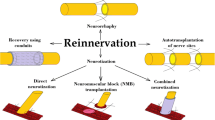Summary
Regeneration of the perineurium after crush injury to the rat sciatic nerve and after autografting was studied in an experimental model. After injury, fibroblast-like cells formed compartments inside the funiculus which gradually acquired the characteristics of the perineurial cell. After grafting, the pattern of perineural regeneration depended on the degree of Schwann cell damage. In the graft and distal nerve trunk the epineurium degenerated and disappeared and new perineurial tissue was formed by endoneurial fibroblasts from the inside of the funiculus. At the suture line, fibroblasts encircled the regenerating axons and the Schwann cells to form new compartments resulting in a large number of minifascicles of regenerating nerve. The function of the perineurium as a diffusion barrier was restored satisfactorily in the crushed nerve, although there was no satisfactory repair at 30 weeks after nerve grafting.
Résumé
Des modèles expérimentaux de neurotripsie et d'autogreffes nerveuses ont été réalisés sur le nerf sciatique du rat afin d'étudier le processus de régénération du périnèvre. Dans la neurotripsie, des cellules de type fibroblaste forment des alvéoles à l'intérieur du faisceau puis progressivement elles présentent les caractéristiques des cellules périneurales. Dans la plastie nerveuse, le mode de régénération périneurale varie avec l'importance des lésions des cellules de Schwann. Dans la greffe et le tronc nerveux distal, le périnèvre disparaît au cours de la dégénérescence wallérienne, puis un nouveau tissu périneural se constitue à partir des fibroblastes endoneuraux. A l'inverse, au niveau des sutures les fibroblastes entourent les axones en voie de régénération ainsi que les cellules de Schwann associées pour former des alvéoles et retrouver les caractéristiques du périnèvre, d'où la formation d'un grand nombre de minifaisceaux nerveux régénérés. Durant le processus de régénération nerveuse, le fibroblaste endoneural joue un rôle important dans la régération périneurale. Le rôle du périnèvre en tant que barrière de diffusion s'inverse correctement dans le nerf écrasé, bien qu'on ne constate pas de réparation trente semaines après la greffe.
Similar content being viewed by others
References
Ahmed AM, Weller RO (1979) The blood nerve barrier and reconstitution of the perineurium following nerve grafting. Neuropath Appl Neurobiol 5: 469–483
Ask P, Levitan H, Robinson PJ, Rapaport SI (1983) Peripheral nerve as an osmometer. Am J Physiol 224 (Cell Physiol 13): c75-c81
Gamble HJ, Breathnach AS (1965) An electron microscope study of human foetal peripheral nerves. J Anat 99: 573–584
Hirasawa Y, Oda R, Nakatani K, Nojyo Y (1974) Experimental study of the regeneration of sympathetic nerve fibers after nerve homografting. Plastic Reconstr Surg 54: 671–675
Ide C (1983) Nerve regeneration and Schwann cell basal lamina. Arch Histol Jap 46: 243–257
Kristensson K, Olsson Y (1971) The perineurium as a diffusion barrier to protein tracers. Acta Neuropath 17: 127–138
Lundborg D, Hansson H (1979) Regeneration of peripheral nerve through preformed tissue space. Brain Res 178: 573–576
Oldfors A (1980) Permeability of the perineurium of small nerve fascicles. Neuropath Appl Neurobiol 7: 183–194
Olsson Y, Kristensson K (1973) The perineurium as a diffusion barrier to protein trancers following trauma to nerves. Acta Neuropath 23: 105–111
Saiki T (1985) Experimental study on the regeneration and permeability of perineurium after peripheral nerve crush injury (in Japanese). J Kyoto Pref Univ Med 95: 1051–1062
Shanthaveerappa TR, Bourne GH (1962) The perineurial epithelium, a metabolically active, continuous, protoplasmic cell barrier surrounding peripheral nerve fasciculi. J Anat 96: 527–537
Spencer PS, Weingerg HJ, Raine CS, Prineas JW (1974) The perineurial window — a new model of focal demyelination. Brain Res 96: 323–329
Thomas PK, Bhagat S (1978) The effect of extraction of the intrafascicular contents of peripheral nerve trunks on perineurial structure. Acta Neuropathol 43: 135–141
Waggener JD, Beggs J (1965) The diffusion of ferritin within the peripheral nerve sheath: An electron microscopy study. J Neuropathol Exp Neurol 24: 430–443
Weinberg HJ, Spencer PS (1978) The fate of Schwann cells isolated from axonal contact. J Neurocytol 7: 555–569
Author information
Authors and Affiliations
Rights and permissions
About this article
Cite this article
Hirasawa, Y., Saiki, T., Nakao, Y. et al. Regeneration of perineurium after nerve injury and autografting. International Orthopaedics 18, 229–235 (1994). https://doi.org/10.1007/BF00188327
Accepted:
Issue Date:
DOI: https://doi.org/10.1007/BF00188327




